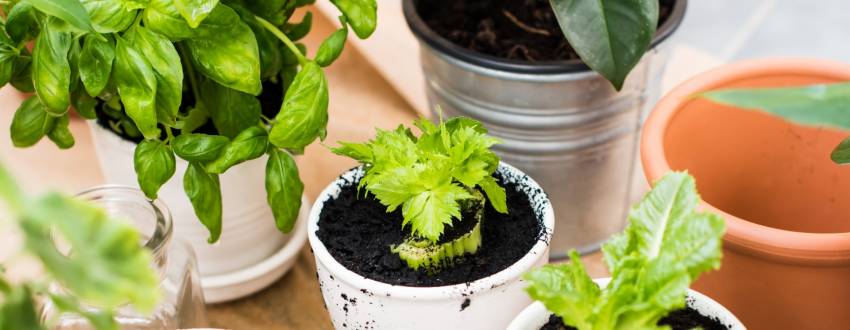Can you believe it’s already June?
Right now we’re entering the third month of COVID-19 restrictions. More masked trips to the grocery store. Kids bored at home, again. Life is far from normal and we’re all desperate for something new and exciting.
With the holidays behind us and the hot weather ahead, there couldn’t be a better time to start a planting project.
If you’re imagining little packets of seeds and lots of legwork, think again. The coolest way to grow produce? From scraps!
What does it mean to grow vegetables from scraps?
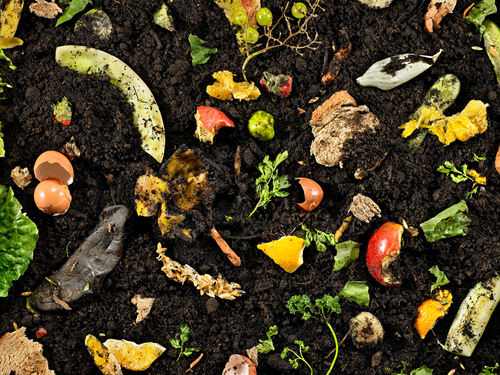
Many plants have the capacity to regenerate from scraps (i.e., the parts that are normally thrown away).
Vegetables like onions, leeks, and even lettuce can be regrown from the roots at the plant base. Herbs like basil and mint can be regrown from stem cuttings. Even potatoes can be regrown from “eye” sprouts.
The ability that plants have to regenerate from scraps seems — like so much of G-d’s amazing natural world — absolutely magical.
Why would I want to grow vegetables from scraps?
There are loads of reasons to embark on a plant-regrowing journey!
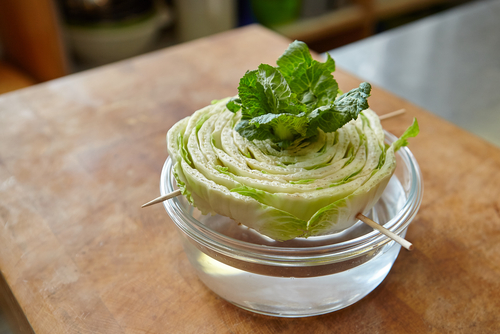
Growing plants from scraps:
1. Saves money
2. Curtails trips to the grocery store
3. Reduces food waste
4. Is a real-life science lesson
5. Makes you feel accomplished
6. Gets your family to eat more vegetables
7. …is just plain fun!
Do I need many supplies to get started?
One of the great things about planting from scraps is that it’s super easy, even for beginners. In fact, you most likely have everything you need to get started.
To begin the process of regrowing plants, you’ll need:
1. Vegetable scraps
2. A clear container, such as a drinking glass, mason jar, or shallow saucer
That’s it!
For some of the vegetables, water is all they need to flourish. For others, once they reach a certain stage of growth, they’ll need to be transplanted into garden soil.
For this second stage, you’ll need:
1. Potting mix
2. A planting spot (in a planter, bucket, garden bed, or directly in the ground)
So, how do I actually regrow the vegetables?
Successfully regrowing produce from scraps will depend on what kind of plant you’re working with.
To regrow scallions (green onions), spring onions, and leeks
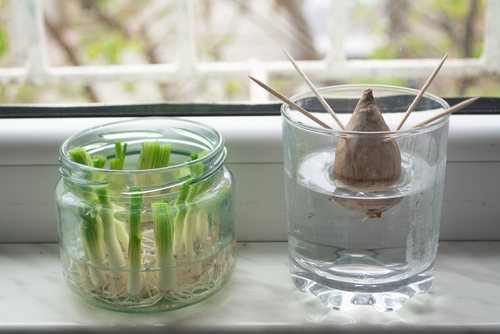
1. Slice off a 1-inch section at the base
2. Place the base in a glass with the root side facing down
3. Add 1/2 inch of water
4. Keep in direct sunlight
5. Change the water every day or two
In about 1 week, you should see enough growth that you can start harvesting the shoots and using them in your cooking.
You can opt to keep the growing plant in water or you can transplant it into soil.
To regrow romaine lettuce or celery
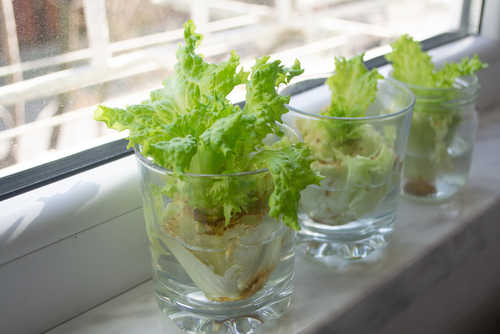
1. Slice off the base of the romaine/celery heart
2. Place the base in a glass with the root side facing down
3. Add 1/2 inch of water
4. Keep in direct sunlight
5. Change the water every day or two
6. When you see roots beginning to grow and new leaf shoots sprouting from the top (within 1-3 weeks), transplant the plant to potting soil
To regrow onions
1. Slice off the onion bottom, leaving about 1-2 inches total
2. Peel off the outer papery layer of peel (be sure to keep the onion roots intact)
3. Place the base in a glass with the root side facing down
4. Add enough water just to cover the roots
5. Keep in direct sunlight
6. Change the water every day or two
7. Once the onion root begins to sprout (should take about 3-5 days), move the entire plant into potting soil, either indoors in direct sunlight, or outdoors
8. When you replant the onion in soil, bury the original onion and its white roots beneath the soil and leave the green shoots peeking out
Water your onion plants regularly. Within a few days you’ll see the green shoots sprouting. Full-grown onion bulbs will take several months to grow.
To regrow basil (this process works for mint and many other herbs as well)
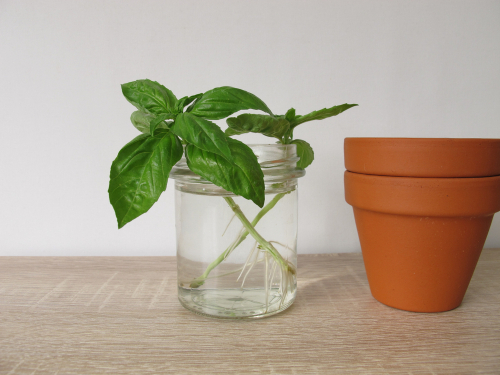
1. Trim the stem, leaving about 4 inches of herb
2. By hand, remove any extra bottom leaves growing from the stems (keep the topmost leaves)
3. Place the cutting in a glass of water
4. Leave in a sunny spot (at least 6 hours of sunlight a day)
5. When you see a large root system growing (within 2-4 weeks) transplant the entire plant into soil
To regrow potatoes
To regrow potatoes, you’ll need a potato with sprouts (also known as “eyes”). Each individual eye can turn into a whole new potato!
1. Cut the potato into chunks, leaving one or two eyes per piece
2. Let the potato pieces sit overnight to dry out
3. Plant the sprouting potato pieces (with the eyes facing up) in potting soil
4. With several months of regular watering and sunlight, you’ll grow a new batch of potatoes
Are there any pro planting tips that can help me in this process?
As with any new venture, growing produce from scraps may take some time, trial, and error to get right. To increase your chances of success, follow these planting tips:
- Instead of transplanting your fledgling plant into regular garden soil, use a specially-developed potting mix
- Instead of gardening directly in the ground, plant your produce into buckets or containers. This will reduce the chance of spreading diseases to the rest of your garden and prevent pests from getting into your plants
- A rooting hormone, like this one, can help your cuttings develop stronger rooting systems
____________________________________________________________________________
If you’re new to planting, try starting with an easy-to-regrow vegetable, like green onions. Once you’re more experienced, you may find yourself experimenting with all kinds of vegetable and herb scraps.
Let the planting adventure begin!


